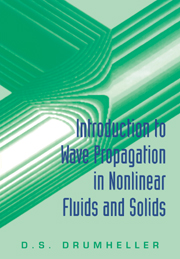Chapter 3 - Thermomechanics
Published online by Cambridge University Press: 05 June 2012
Summary
In the late seventeenth century, Isaac Newton presented the fundamental concepts of motion, force, and momentum. With these concepts, he made many successful predictions of physical phenomena; however, when he attempted to predict the speed of sound in air, he failed. It was not until a century later, when the distinction between temperature and heat was understood, that Laplace was able to achieve an accurate prediction of this wave velocity.
As in Newton's day, we often do not appreciate that even weak elastic waves cause changes not only in stress and strain but also temperature. Because these temperature changes are small and reversible, they are not in our common perception. In contrast, strong shock waves cause irreversible changes in temperature. Most solids when subjected to repeated hammer blows become noticeably hotter to the touch. To describe the distinctions between these types of waves, we must introduce the fundamentals of thermodynamics, including the concepts of heat, temperature, and entropy.
Why must we study thermodynamics? In Chapter 2 we studied a wide range of wave phenomena using the mechanical concepts of force and motion. Using only the constitutive model for an elastic material, we developed detailed analyses of the nonlinear structured wave, the transition of a compression wave into a shock wave, and the decay of a shock wave as it is overtaken by a rarefaction wave. We have analyzed wave motion in solids, liquids, and adiabatic gases.
Information
- Type
- Chapter
- Information
- Introduction to Wave Propagation in Nonlinear Fluids and Solids , pp. 233 - 320Publisher: Cambridge University PressPrint publication year: 1998
